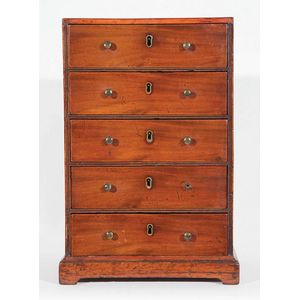Antique Australian 8-Drawer Print Cabinet
You must be a subscriber, and be logged in to view price and dealer details.
Subscribe Now to view actual auction price for this item
When you subscribe, you have the option of setting the currency in which to display prices to $Au, $US, $NZ or Stg.
- Kauri - An evergreen conifer tree associated with New Zealand, but also grown in northern Australia, and islands around the Pacific rim including Borneo, Vanuatu and New Guinea. The timber is generally golden in colour, and straight grained without much knotting.
A by-product of the kauri tree was the kauri gum, the fossilised resin extracted from the tree. The gum was obtained through digging, fossicking in treetops, or more drastically, by bleeding live trees. Kauri gum was used in the manufacture of varnishes and other resin-based products, and also crafted into jewellery, keepsakes, and small decorative items.
Kauri forests were prolific in the north of the North Island of New Zealand. European settlers in the 1700 and 1800s realised that the timber from these tall trees with broad trunks would be ideal for ship building and construction and a thriving industry was established harvesting the kauri tree. The forests were substantially reduced, and now the remaining Kauri trees that grow in New Zealand are protected, and there are reserves in various areas of the North Island.
The remaining stands of kauri in New Zealand are under threat from "kauri disease", a microscopic organism that causes dieback in the trees, with vast tracts either dead or dying. - Circa - A Latin term meaning 'about', often used in the antique trade to give an approximate date for the piece, usually considered to be five years on either side of the circa year. Thus, circa 1900 means the piece was made about 1900, probably between 1895 and 1905. The expression is sometimes abbreviated to c.1900.
This item has been included into following indexes:
Visually similar items

Early 19th century mahogany specimen cabinet the six drawers with small brass handles

An antique eight drawer plan cabinet in Victorian Ash, late 19th to early 20th century, the cabinet with a mitred top with a tooled ox blood leather insert above eight shallow drawers each with pairs of metal cup handles and raised on a plinth base. Height

A seven drawer plan cabinet in Victorian Ash, circa mid 20th century, the deep cabinet with a low gallery to the rear, with shallow drawers each with metal cup pull handles and small metal frames for holding identification cards. Height 91 cm. Width 94 cm.

A Victorian cedar secretaire Wellington chest. Later 19th century, the chest with six drawers of differing depths, one with a faux front serving as a fold down writing plane and concealing two half width drawers and four pigeon holes, with acanthus carved
